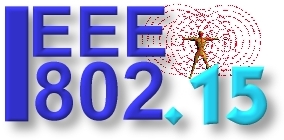
IEEE 802.15 WPAN
Task Group 8 (TG8)
Peer Aware Communications
|
| IEEE Wireless Zone |
| IEEE 802.18 RR TAG |
| IEEE 802.19 Coex TAG |
| IEEE 802.20 MBWA |
| IEEE 802.21 MIHS |
| IEEE 802.22 WRAN |
| IEEE 802.23 ES |
Overview
This standard defines PHY and MAC mechanisms for Wireless Personal Area Networks (WPAN) known as Peer Aware Communications (PAC). PAC is optimized for peer to peer and infrastructureless communications with fully distributed coordination.PAC features include:
discovery of peer information without association,
discovery signaling rate, typically 100 kbps,
scalable number of devices during discovery,
scalable data transmission rates, typically 10 Mbps,
simultaneous multi-group communications, typically up to 10,
relative positioning,
multi-hop relay,
security,
operation in globally available unlicensed/licensed bands below 11 GHz capable of supporting these requirements.
Current Status
TG8 received NesCom approval on March 30th 2012. Call for Applications was issued. TG8 held its first meeting at the 802.15 Interim meeting in Atlanta May 2012. During the meeting, the group selected TG officers. Presentations were given on response to Call for Applications, and agreed on the TG procedure and timeline.TG8 approved Technical Guidance Document and Channel Models Document during the July 2012 meeting. Call for Proposals was issued during the March 2013 meeting. TG8 started discussing PAC Framework Document, based on submitted proposals, from the September 2013 meeting. PAC Framework Document was approved and Call for Contributions is issued during the January 2014 meeting. TG8 started discussing harmonization of proposals targeting the specification draft during the July 2014 meeting.
During the September 2014 meeting, TG8 started drafting the specification for high level MAC items, including network synchronization, frame structure, data transmission period, discovery and peering. The UWB PHY specification was presented for data transmission. During the November meeting, TG8 began to introduce specification text for: distributed network synchronization procedure, frequency channel selection, distributed open-loop power control for the CFP, narrowband, wideband and UWB PHYs. TG8 started discussing about security for PAC and adaptive random access for the CAP.During the January 2015 meeting, TG8 started defining MAC/PHY superframe parameters for synchronization, discovery, peering and communication period. Also, TG8 started discussing MAC/PHY General Requirements and Services and ranging for the UWB PHY. During the March 2015 meeting, TG8 finished the distributed network synchronization specification, channel scanning, PHY general requirements and services, MAC architecture and MAC Tx, Rx, and Ack scheme. During the May 2015 meeting, TG8 finished editorial changes to acronyms, definitions and general description of the specification; Also TG8 addressed MAC topics as MAC commands, channel access, device discovery and MAC addressing for unicast and multicast. During the July meeting, TG8 approved text for the UWB PHY related to relative positioning and location, as well as peering, depeering and closed loop power control for the MAC. During the September 2015 meeting, TG8 finish the text specification for MAC services, random access for peering (association) and CAP; and the cryptographic keys agreement protocol.
During the November 2015 meeting, TG8 drafted the scenarios and procedures for multi-cast sessions: one-to many and many-to-many group communications. Also, TG8 finished remaining items for the MAC clause such as MAC commands, MAC frames (including IEs) and cyclic super-frame structure for power management. Also, TG8 drafted CAP optimization and distributed CFP.During the January 2016 meeting, TG8 started reaffirming approved motions during teleconferences. Also, TG8 finished one-to-many and many-to-many peering and de-peering procedures. TG8 approved the spreadsheets for submitting Comments and Comment-Resolution ballots. During the March 2016 meeting, TG8 started working on the last TBDs and Coexistence Assurance Document. TG8 began the first internal Draft's review. During the May 2016 meeting, TG8 issued the Draft Standard v.1.0 for letter ballot. During the July 2016 meeting, TG8 started to work on comment/resolution to first letter ballot. During the September meeting, TG8 resumed to work on comments/resolutions to LB122. During the November meeting, TG8 finished comments/resolutions to LB122.
During the January 2017 meeting, TG8 finished comments/resolutions to LB132. During the March meeting, TG8 finished comments/resolutions to LB135 and requested conditional approval to start Sponsor Ballot. During the May meeting, TG8 started addressing comments to initial sponsor ballot. During the July meeting, TG8 finished comment/resolution to the initial sponsor ballot and prepares for the next recirculation. During the September meeting, TG8 finished comment/resolution to 2nd sponsor ballot recirculation and prepares for the next recirculation. During the November meeting, TG8 prepared the Revcom package motion for the WG approval.
IEEE 802.15 TG8 Project Main Documents
- Project Authorization Request: PAR
- Five Criteria for Standard Development: 5C
- Presentation at Wireless Next Generation Standing Committee: 15-12-0046-01
- Technical Guidance Document: 15-12-0568-10
- Channel Models Document: 15-12-0459-07
IEEE 802.15 TG8 Time Line
| TG Formation | March 2012 |
| TGD Approval / Call For Proposals | March 2013 |
| Preliminary Proposal Presentation | May 2013 |
| Final Proposal Presentation | July 2013 |
| PFD Approval / Call For Contribution | January 2014 |
| Harmonization Milestone | November 2014 |
| Draft Specification | March 2015 |
| Initial Letter Ballot | May 2016 |
| Initial Sponsor Ballot | May 2017 |
| RevComm Submission | December 2017 |
How to participate
- Participate by attending our Meetings.
- TG8 conducts its discussions on
the 802.15 TG8 Private Mailing List. You can learn more about the
802.15 Mailing Lists by pointing your browser here.
Information
- 802.15.8 Task Group documents are available at Mentor Archive.
- 802.15 documents are available on the Document Archive.
Sessions & Milestones
Who to contact with questions
- Chairman: Myung Jong Lee (CUNY)
- Vice-Chair: Huan-Bang Li (NICT)
- Technical Editor: Marco Hernandez (ITAM, NICT)
- Co-Editor: Billy Verso (Decawave)
- Secretary: Marco Hernandez (ITAM, NICT)